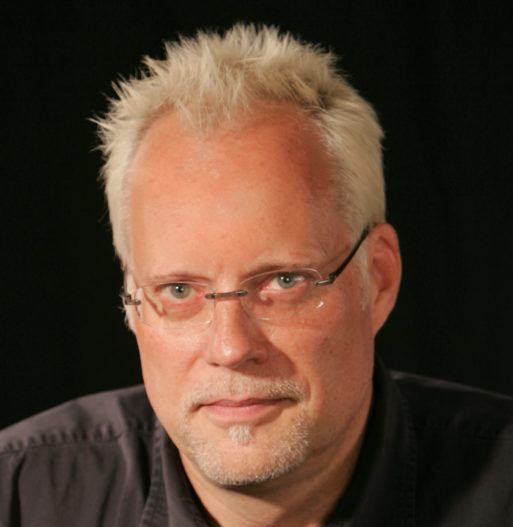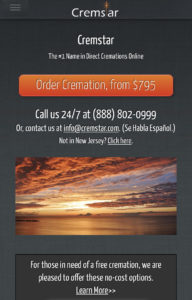
Cremstar founder and former ad exec J.G. Sandom, is looking to disrupt the funeral industry with online direct cremations.
Cremation is seeing a digital transformation behind the imagination of a former New York ad exec. J.G. Sandom spent almost 40 years in the advertising business before he started his latest venture, Cremstar, in 2014. He founded one of the first digital ad agencies, Einstein and Sandom Interactive, in 1984, and got elbow-deep in the digital space by pioneering some of the first digital marketing campaigns in the nascent World Wide Web. He even worked for then-big-4 global ad agency Ogilvy and Mather for a stint in the late 90s as Director of Interactive.
However, Cremstar was not his first effort to make memorials digital. In 2015, he developed MemoryBox, a photo and video hosting site and app centered around collecting shared memories, usually for specific events.
“It’s been used in protests like the Women’s March and in the Middle East. It’s been used by New York and LA AIDS Walk. Wedding planners used it,” Sandom said.
And so did a number of people going to funeral homes to memorialize lost loved ones, Sandom noticed. A few tragic events, one national and one personal, brought him into what he calls “death tech.”
Over 14 years later, he is pitching a more affordable way to cremate a loved one, to ease the burden not just on families but also the earth. Cremations start as low as $795 on the website, and the direct cremation process avoids the harmful chemicals used in embalming that can leak into the ground, as well as chemicals used in caskets.
“Do you really want your last legacy to be burning fuels or eco-friendly?” Sandom asks.
Wherever possible, Cremstar uses a method called aquamation, or alkaline hydrolysis, which breaks down remains in water and an alkaline chemical as opposed to flame-based cremation.
He hopes that making cremation more accessible and aligning with a generation that’s “more secular and less traditional” will lead more people to realize its benefits.
“Forty years ago, only 5% of Americans were cremated.” Today, more than 56% of Americans are cremated, and in some states, the cremation rate is greater than 80%. We’re taking advantage of these trends with an offering suited to the digital age.”
SevenPonds sat down with Sandom to talk about this unique option for families looking for cremation, the environmental costs of burial and their solutions, along with a smattering of Eastern philosophy.
Editor’s note: This interview has been edited for length and clarity.
How did you get to a cremation business with roots in creative and advertising?
It was a confluence of things. My father passed, and I had to experience the reality of deathcare in this country. It was so focused on selling you something. I also had friends who had lost stuff in Katrina. That’s where MemoryBox came from. I had realized those memories demanded a better mechanism for memorialization. MemoryBox allows people to upload their photos during a certain time period or tagged to a certain event, and all of them get automatically added to the same folder online. From there I got to thinking about the end-of-life process, and the more we looked into cremation, the more we saw how backwards it felt. Meanwhile, everything around it was going online.
For those unaware, what is online direct cremation?
Everything is facilitated through technology. You go to Cremstar and notify us that the person has passed and give any information about where the body is getting picked up from, what they look like and how you want to pick up the remains. This can happen whenever you’re ready. You can spend as little or as much time with your loved one as you want before starting that. Then we’ll contact a local funeral director who will arrange the pick-up of the body. We track the drivers from when they leave to when they get back. The drivers also add a “digital toe tag” that we use to track whether the body has been picked up. From there, once the death certificate is processed, the decedent can go to the crematorium. We keep the family apprised of the location of their loved one. Then we can arrange shipping of the remains through the United States Postal Service, or free pick-up of the remains.
How do you verify that the family is putting in this request?
Cremstar’s funeral directors contact every family by phone or via Zoom to verify who they are. Just as in the offline world, next-of-kin are also obligated to sign, under penalty of fines and even imprisonment, all the forms required by the state. In our case, they sign online, with a mouse or a fingertip if they’re using a smartphone. We even have smart logic helping them to identify the correct next of kin. Each state is different with different requirements. In New York, you only need one parent or one child or a sibling to sign off. In Pennsylvania and New Jersey, you need the majority. Our system automatically addresses these distinctions.
We also leverage our own proprietary Styx Logistics app that our Cremstar funeral directors use to assign and dispatch drivers. The app allows for data about the decedent to be transferred to a digital toe tag (wristband for the decedent or sealed body bag) so they’re always identified from the time of pick-up. We then follow the driver via GPS from the initial removal to the final cremation at the crematory. Everything is automated and tracked through the app.

Cremstar’s Homepage
How far will Cremstar travel/arrange travel to pick up a body?
We currently operate with licensed funeral directors, certified removal personnel and state-inspected crematoria within the New York Metro area, New Jersey and eastern Pennsylvania.
You wrote in this piece on Medium about Eastern influences and death. How does that influence the work you’re doing with direct cremation?
[Cremstar CTO] Penny Goodwill and I have both been fortunate enough to have lived in a host of different countries that looked at death differently throughout our lives, and we’ve always sought to understand and appreciate those different cultures. I guess you could say our larger mission is to “rebrand” death, to get us to look at it differently. It’s about honoring the person in a way that is real today and not 100 or 200 years ago when these Western practices became common. Death is a most natural part of every life. Indeed, it is its finitude that gives life its special meaning. We need to reinvent the way we look at aging and death in this country, and also the way we think about legacy. Your legacy is not just something you should consider as death nears — where you should leave your money, your things. You make your legacy every day as you create and archive the memories you want to be remembered by when you’re gone.
What is in Cremstar’s future? I understand you have plans to expand.
Oh well, where do we start (laughs). We want to be anywhere there’s funeral homes and crematoria. We’re planning to expand to Florida, Delaware and Maryland over the next few months. We’re looking into providing more eco-friendly options, like aquamation, where what’s leftover from the process is green and can be used to nurture a plant with the decedent’s LifeStream, as we call the water remaining after the bones are removed to become ashes. Imagine getting a living plant — a bonsai or rose bush or evergreen — nurtured by your departed loved one’s LifeStream that you can plant in your backyard or in a pot in your living room, and not simply ashes in an urn. Imagine a columbarium of such plants, a “green wall” of living tributes. That’s where we’re headed.
We’d also like to work to incorporate MemoryBox in a variety of ways. We’re working on adding VR to create a virtual “memory palace” with all photos and videos and sound files from MemoryBox — like how a funeral director would set up a room with personal items and pictures—that you can view through a headset or browser.
What is one piece of advice you have for a person planning a cremation?
The most important thing is that there are no rules. Don’t let established scripture or family pressure tell you what you should be doing. Today more and more people are creating and holding life celebration events months or even years after the passing. There’s no rush with ashes. You should have that conversation with your loved ones and think about it, see if your needs or wants change as you get older. Just do what’s right for you.

 Cremation’s Going Digital
Cremation’s Going Digital


 “Help Me, Helen”
“Help Me, Helen”
 Recovering Cremation Remains After the Los Angeles Fires
Recovering Cremation Remains After the Los Angeles Fires
 “As Tears Go By” by Marianne Faithfull
“As Tears Go By” by Marianne Faithfull














